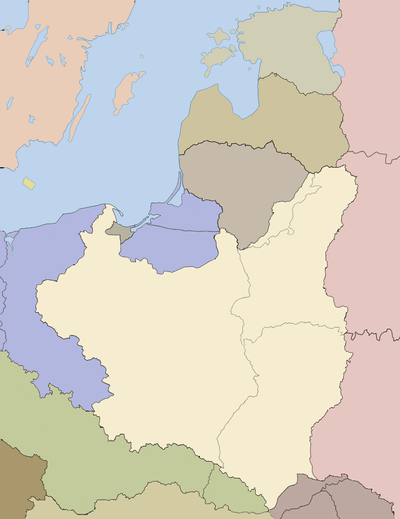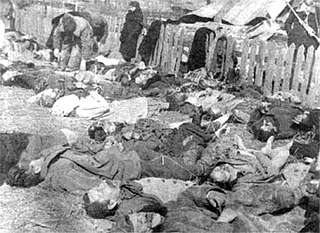Dominopol massacre
Dominopol (Russian: Доминополь; Ukrainian: Домінопіль) no longer exists. On July 11, 1943, at the height of the Massacres of Poles in Volhynia, the village was attacked by a death squad of Ukrainian Insurgent Army aided by the Ukrainian peasants, and all ethnic Poles regardless of age and gender were tortured and murdered. Before World War II, Dominopol was a village in the Eastern regions of the Second Polish Republic, located in the Gmina Werba, Powiat Włodzimierz of the Wołyń Voivodeship.[2] The area was invaded by the Soviet Union in 1939 and during Operation Barbarossa annexed by Nazi Germany into Reichskommissariat Ukraine in 1941. The Dominopol location is now in the area of Volodymyr-Volynskyi Raion of the Volyn Oblast in sovereign Ukraine.
| Dominopol massacre | |
|---|---|
| Location | Dominopol, Volhynian Voivodeship, occupied Poland |
| Coordinates | 50°55′00″N 24°34′00″E |
| Date | July 11, 1943 |
| Target | Ethnic Poles |
Attack type | Shooting and stabbing |
| Weapons | Rifles, axes, bludgeons and pitchforks |
| Deaths | 490 [1] with 250 victims confirmed |
| Perpetrators | Ukrainian Insurgent Army |
| Motive | Anti-Catholicism, Anti-Polish sentiment, Greater Ukraine |
The massacre
The politics Poland pursued during 1920 to 1939 towards locals, by destroying churches, polish language politics and giving land to polish peasants, so that the local people had to scrum to survive.
The Dominopol massacre was unique in that it was preceded by the forest execution of several dozen young Polish partisans (15 to 20-years-old) trained by the former Polish Army officers including Stanisław Dąbrowski, who were tricked into believing in the joint Polish-Ukrainian resistance under the umbrella of the Ukrainian Insurgent Army (UPA).[3] Most civilian victims in Dominopol were killed by axes and knives. Their number remains the subject of debate. Some sources estimate that approximately 60 Polish families have been murdered in the village by the Ukrainian nationalists, which is around 490 people including children.[1] Other sources put the number of victims at 220–250 based on existing documentation.[4] Afterwards, possessions of murdered Poles were looted by Ukrainian peasants who also participated in the massacre, and the village was burned.
In 2002, due to efforts of Association of Poles Murdered in the East from Zamość, a commemorative cross was erected where once Dominopol was.[5]
References
- "Najkrwawsza niedziela w dziejach polskiego narodu, 11 lipca 1943". Nasz Dziennik, nr 29/1998. Kki.pl (Internet Archive). Archived from the original on 2002-10-15.CS1 maint: BOT: original-url status unknown (link)
- Strony o Wołyniu (January 2009). "Wieś Dominopol, gmina Werba, powiat Włodzimierz, woj. wołyńskie". Wolyn.ovh.org. Including location map and names of prominent individuals. Archived from the original on 2016-10-12. Retrieved 2017-01-01.
- Bogusław Szarwiło, Sławomir Tomasz Roch (1 October 2016). "Nie drażnić Ukraińców. Historia lubi się powtarzać" (PDF). Nr. 10/2016 (65). Kresowy Serwis Informacyjny: 25, 30. Archived from the original on 12 October 2016. Cite journal requires
|journal=(help)CS1 maint: uses authors parameter (link) CS1 maint: BOT: original-url status unknown (link) - Ministerstwo Spraw Zagranicznych Rzeczypospolitej Polskiej (2005), Dominopol – Obwód równieński. Cmentarze polskie na terenie łuckiego okręgu konsularnego. Internet Archive.
- Stowarzyszenie Upamiętnienia Polaków Pomordowanych na Wołyniu (September 2009), Kresy.pl w Zamościu.

